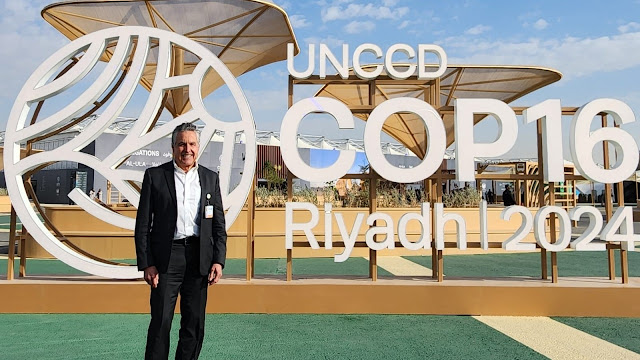Reflections from UNCCD COP16 in Riyadh, December 2024
Guest blog by Charles McNeill Senior Fellow, Meridian Institute, former Senior Advisor, Forests & Climate, Interfaith Rainforest Initiative, UN
I participated in the UN Convention to Combat Desertification (UNCCD) COP 16 that concluded last week (13 December 2024) in Riyadh, Saudi Arabia - with more than 20,000 participants from 197 countries -- and the outcomes were both encouraging and deeply sobering.
Although I have spent my UN career supporting the implementation of two of the three global Conventions emerging from the 1992 Rio Earth Summit – the ones on Climate Change and Biodiversity – this was the first time I participated in a COP for this ‘third’, and lesser known - but extremely important -- Rio Convention devoted to stopping desertification, land degradation and drought.
I now understand much better how absolutely central this ‘Land’ agenda is to global efforts to address the linked crises of climate change, biodiversity loss, food insecurity, migration, and even global security – and how unsustainable agricultural practices are driving these crises.
The G20 Global Land Initiative invited me to this COP 16 to advise on how faith communities can be introduced to the urgency and opportunity of land restoration, along the lines of my work with religions to protect tropical forests and indigenous peoples’ rights through the Interfaith Rainforest Initiative (IRI) www.interfaithrainforest.org.I believe there is a huge potential for faith communities to get involved and I spoke in a number of events about that, including here:
- “Faith Stories of Restoration”
- “Sowing Seeds of Faith: Cultivating a Decade of Restoration”
- And a ‘Fireside Chat’ Interview on “Engaging the Faith Community in Land Restoration”
\What I learned at this COP was stunning:
1. Land degradation is severely undermining Earth’s capacity to sustain humanity because even as dramatic water-related disasters such as floods and storms intensified in some parts of the world, more than three-quarters of Earth’s land became permanently drier in recent decades. And now, for the first time, science is showing that industrial emissions of greenhouse gases were the major culprit (as if we needed another reason to phase out fossil fuels and to stop deforestation!)
2. Aridity is the world’s largest single driver behind the degradation of agricultural systems – and 40% of Earth’s arable lands is already damaged -- affecting over 3.2 billion people, with the highest costs borne by those who least deserve it and can least afford it: indigenous communities, rural households, smallholder farmers, youth and women.
3. Nearly one in three people live in moisture-deprived areas, up from one in five in 1990, and nearly one in four people (close to 2 billion) lived under drought conditions in 2022 and 2023. If current trends persist, 3 in 4 people will be affected by drought by 2050.
4. Worldwide, in recent years nearly 400,000 square miles of the planet’s healthy and productive land has become degraded annually.
5. The drier climates now affecting vast lands across the globe will not return to how they were and this change is redefining life on Earth. Rising aridity and drought play a key role in increasing human migration around the world – and political instability.
6. An estimated $1 billion/day is needed to restore land but already $2 billion/day of public funds are being spent on agricultural subsidies – and most of these subsidies are harmful to the environment. So the funds needed for restoration are available, but they are being spent on the wrong things!
WHAT WAS ACHIEVED AT UNCCD COP16:
1. During the 12 days of UNCCD COP 16 negotiations, many significant decisions and financial pledges were announced, including over $12 billion to address land degradation and drought across 80 vulnerable countries under the Riyadh Global Drought Resilience Partnership. Countries also agreed to mobilize private-sector engagement through the Business4Land Initiative.
2. The Riyadh Action Agenda www.riyadhactionagenda.org/ -- a global platform mobilizing ambitious commitments and action from governments and non-state actors to conserve and restore 1.5 billion hectares of land by 2030 -- is another important outcome from this COP.
3. Indigenous Peoples and local communities received strong recognition as countries agreed in a landmark decision to establish a caucus to ensure their full representation.
4. The lack of decisive action to eliminate harmful subsidies was a missed opportunity at this COP. Similarly, the UNCCD COP failed to agree on establishing a drought financing protocol and pledges made were small compared to the USD 355 billion required annually by 2030.
UNCCD COP16 raised visibility and set the stage for land restoration and resilience-building to take its rightful place on the global sustainability agenda. As always, the challenge will be turning the agreements into the transformative action we all need.
My take-home learning is that these “Land’ issues and this Convention deserve super enhanced support and engagement from all of us!
Important Recent Reports Worth Reviewing:





Comments
Post a Comment